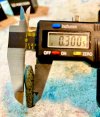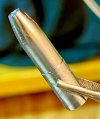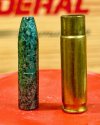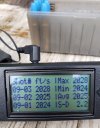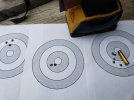Centaur 1
New Member
I finally got around to shooting my new to me, 1965 Marlin 336 in 35 Remington. I was using the Lee C358-200-RF, cast with clip on wheel weights, powder coated with Eastwood squirrel grey, air cooled, and a Hornady gas check. I really like using the powder coat, because it just works so well. New gun, new bullet, my first attempt, I was using data that lists the velocity at over 1900 fps using Reloder 10x. It was only a quick trip to try the gun, but I shot two 5 shot groups that all touched.
The only problem is that the powder coating adds just enough to the diameter of the nose, that it engages the rifling and makes the lever stiff to close. This is not a problem for shooting at the range, but it could be a pain to hunt with. My idea is to wrap the nose of the bullet with a high temperature tape before powder coating, then peel it off after baking. I have two rolls of Scotch Hi Temp Acrylic, a roll of Saint-Gobain kapton, and a roll of aluminum tape. Shrink tubing might also work, but would be harder to work with.
Has anyone tried this before? Did it it work?
The only problem is that the powder coating adds just enough to the diameter of the nose, that it engages the rifling and makes the lever stiff to close. This is not a problem for shooting at the range, but it could be a pain to hunt with. My idea is to wrap the nose of the bullet with a high temperature tape before powder coating, then peel it off after baking. I have two rolls of Scotch Hi Temp Acrylic, a roll of Saint-Gobain kapton, and a roll of aluminum tape. Shrink tubing might also work, but would be harder to work with.
Has anyone tried this before? Did it it work?

